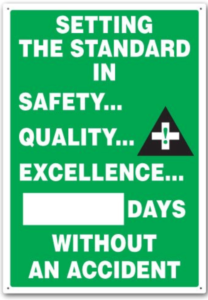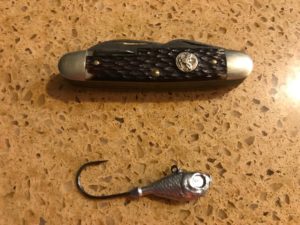If you are a regular reader of our blog, you will recall the continuing battle we have with keeping hooked Snook away from dock pilings or from sawing through our leader with their sandpaper like teeth. The result of that unfortunate eventuality is a snapped line, but more importantly (and costly) is the loss of the lure that is attached. The other similar, but equally as costly danger we face, is that certain fish, ladyfish in particular, but Snook as well, chew the buck tail hair off of the back of the jig, leaving mostly just a head and a hook. A Spro jig can cost something around $5-$6 depending on the sale and shipping costs from the various pirates (I mean fine retail providers) of these precious jigs. There have been busy nights of snooking where we have lost six or more jigs between the two of us. You can do the math (I would rather not right now, thank you).
As we go about our internet searches to resupply our habit and complain about the high cost of the jigs available (which many times are in short supply even at the retail or tackle marketplace), or as we sit and look at the pile of pitiful jigs with a few strands of buck hair left awkwardly dangling from the old jig head, we often return to a similar discussion. “Seems cheaper in the long run to make and repair our own jig, right?”, “Wonder how hard it would be to get the stuff to do that?”, “We need to look into that one of these days.”, “We need to place this jig order now because I am about out.”, “Maybe one day we will check that out.” Isn’t that the way many of our conversations go in life? One day. One day. And then “one day” never comes, or when we finally get around to the “one day”, we do not have the money or energy or physical capability to do the thing we waited until “one day” to do.
As a disrupter of the status quo these days (who, old David the risk avoider? – yes), I pulled the trigger on the equipment and supplies to give jig making a shot. Since we are approaching Jason’s birthday, what a good excuse to invest in something that he has been contemplated for ten years of “some days”? As the boxes arrived, it was becoming more and more difficult to keep the surprise, so I just decided to have Jason open the fun stuff early. Melting pot, jig head mold, hooks, powder paint, thread wrap, epoxy stuff, synthetic buck hair, and little sticky eyes (actually those are still on a boat coming from China I think). All in all, not a huge investment or a complicated concept, but as with all projects of this nature, a learning curve is involved. Oh, did I mention jig making involves melting and molding lead at high temperatures? What could possibly go wrong, right? After watching the requisite YouTube videos on the making of buck tail jigs, and re-watching the key ones about the process, we decided we could wait no longer and decided to have a first run at making the jig heads, which is the first step.
Now just for the record, this would not be the first time I have worked with lead. Back when I was a teenager with lots of time on my hands, home alone while my mom worked retail, I had a summer where I decided it would be cool to use a bottle cap to melt some lead fishing sinkers. Placing the metal bottle cap directly on the electric stove, carefully using pliers to handle the “pot”, stove eye set on high, generated the necessary heat to melt the lead. My smelting operation got a bit more sophisticated as I went along, and I learned about scooping off the dross (impurities) that floated to the top to produce a very shiny silver lead bottle cap shaped thing. Fun, cool, but ultimately useless in the end. The market for bottle cap shaped paper weights was at a historic low unfortunately for me, or my career may have taken a different path. Fortunately for me I did not set the house on fire, spill the lead on the kitchen carpet, into the stove eye, or on me. Of course this was just one of those things that boys do growing up because they have time on their hands, an imagination at work, and manly building instincts raging (or were those hormones, can’t really remember…).
So since I was bringing my extensive metallurgy and lead smelting experience into the effort for our first attempt, I felt fairly comfortable that we could accomplish the simple task of melting some lead, pouring said lead into a preformed mold, and repeating that task as necessary to have a successful first run of jig production. The hard part I thought would be the part where we paint and add all the feathers, hair, and flash stuff to the jig. Which I am not extra excited about based on my previous challenging experiences of trying to do that with tiny trout flies some time ago. In retrospect, a quote I saw from a female adventurer that lead the first women led team to the pinnacle of Mt. Everest which read “Fear, as long as it is not paralyzing, is fine—it’s just a normal, human emotion. But complacency will kill you.” She indicates that most deaths on Everest come when climbers are coming down the mountain, where things seem easy and gravity is on your side. Loss of focus for one second and tragedy occurs. That is so true of every situation of life, and was about to enter the Snook Brothers smelting operation without warning (well, maybe there was a bit of warning, just unheeded).
Since this was just going to be a first run to test the equipment, pour a few small jigs in the mold, checking the basics and then get serious on another day, we created our table setup, set our equipment in place, got some gloves, wearing shorts, bare feet and got ready to give it a go. Wait, what? Shorts, bare feet? Aren’t we creating liquid metal that melts at hundreds of degrees (621.4º to be exact), and metal that guys in hazmat suits and respirators come into old houses and remove? Something was wrong with that plan from the start. I know there is more evidence that red tide includes some mental affects, but I will admit I do not think that was the issue here. I think it was the same boyhood interest in melting stuff, making something from nothing, and really not thinking about the dangers that much. After all, I was not cooking this on the stove with a carpeted floor, right.
Things went well right from the start. Lead in the pot melted fairly quickly. Teresa had ordered pure lead, not refurbished tire weights and such that can be dirty, so the melted liquid was clean and shiny. We followed the direction and poured some a few runs into the mold without a hook in place to warm up the mold. With a little practice, we were able to pour into the mold accurately and at the right pace to allow the lead to flow down into the crevasses of the jig mold without missing parts. We were ready for prime time. Did I mention the cord on the melting pot was about two feet long and the feet of the heating element base for the pot was a bit tipsy?
When we added the hooks to the mold, we achieved initial success, but then began to discover incomplete mold forms were happening. We tried this, and we tried that, to try to make things form as they should. As our obsession and focus moved to the mold and jigs and away from the process of carefully handling the pot of molten lead, I caught the short cord on the base, and set the pot down at an angle, which spilled the hot lead onto the table and onto the floor. As it was clear what was happening, I called out to Jason to “Watch Out!” As we both did a quick dance to jump back and away from the splashing lead, we narrowly averted total disaster of being coated with the searing liquid. Unfortunately, Jason could not escape totally and his foot was splashed in several places. We did our best to clean up the mess, which came right off the floor and table due to the chemical properties of the lead. Time to shut down the operation and put the sign out “Days Since Last Accident: 0”.

As we went upstairs for some treatment on the burns, a cold fizzy seltzer drink, dessert, and coffee, we watched as Jason’s burns blistered and burned. I went and cut some Aloe from my back yard to try to ease the pain. I felt terrible to have caused this pain, and to have been so careless. In the midst of all of this, Jason continued to hold the one good jig we made in our initial run, admiring the shape, detail, hook quality and potential to be a real Snook killer jig and casually said “All I can think about is going back downstairs and pouring some more jigs”. Now that my friends is the essence of the Snook Brother spirit at work. Intense, hard core, fearless, adventurous, diligent, and um, crazy? Yeah, I deferred on that thought and told him we would need to regroup and come back for the next run better prepared for our next go at it. So we settled for re-watching the videos of how others made their jigs with ease and never once did they spill their lead all over the place and have to scramble for safety. Learning comes from doing, and sometimes we make mistakes. Failure is only a negative if we learn nothing from the mistakes we make. Innovation and ultimate success most always follows failure of some type. We shall overcome!
David

